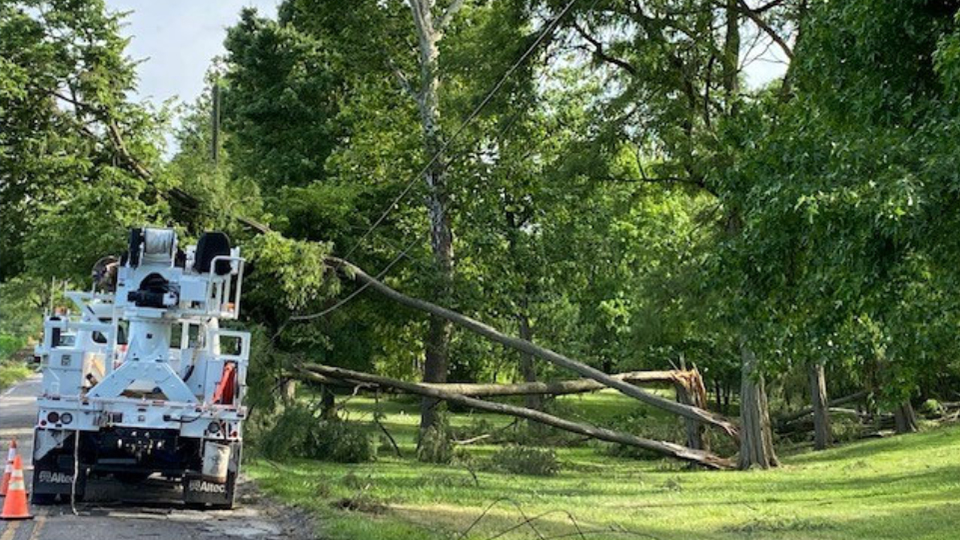Indiana utilities outline outages, responses to major storms
Subscriber Benefit
As a subscriber you can listen to articles at work, in the car, or while you work out. Subscribe Now
INDIANAPOLIS - Four Indiana power companies reassured the Indiana Utility Regulatory Commission that they adequately monitored severe weather conditions and promptly resumed power for thousands of Hoosier customers during a week of heavy storms earlier this summer.
The utilities gave updates last week about their response to multiple extreme weather events — including those that produced heavy rain, high winds and several tornadoes — which tore through various areas of Indiana between June 29 and July 4.
The IURC requested the meeting and asked each utility to provide an after-action summary of the weather event, including the impact of the storms during that time span, the number of customers impacted, the utility’s response to the outages, the common cause of the outages during that time frame, and any lessons learned from the restoration process.
Representatives from the Northern Indiana Public Service Company (NIPSCO), Indiana Michigan Power, Duke Energy and CenterPoint Energy outlined their responses to the storms, discussed how they will react to future serious weather events.
A second, individual conference with AES Indiana is scheduled for next week.
Meetings with the state’s “big five” investor-owned utilities is a response to — but not a fulfillment of — an inquiry aimed at AES, which serves Hoosiers living in the Indianapolis area.
Storms left an estimated 100,000 customers without power between June 29 and July 4, according to AES. That prompted customer advocates to ask regulators on July 11 for an investigation.
The commission cautioned that the technical conferences are for “information gathering” only, and that it hadn’t yet decided whether to launch a formal investigation.
There was little public testimony or discussion from commissioners.
Restoring power
During the worst of the storm events on June 29, Duke Energy — Indiana’s largest electric utility — recorded 3,684 outage events affecting a cumulative 212,318 customers that day.
At the peak, more than 149,000 Duke consumers experienced an outage at the same time, according to the utility. Over the next five days, as more storms rolled through Duke’s service area, more than 40,000 more customer outages were reported.
The widespread nature of the storm affected nearly all of Duke’s 32 Indiana operations centers, company officials said. A series of new storms that followed made power restoration “especially challenging,” they added.
CenterPoint representatives said six successive storm fronts across multiple days left 19,429 customers out of power after the worst of the weather rolled through June 29. Crews recorded more than 65,000 customer restorations over the stormy week, completing nearly 3,400 total ticket calls.
NIPSCO representatives said their service territory was less impacted than in other areas of the state, however. The utility reported 81 outages affecting 5,270 customers during the heavy storm period. About 2,500 customer outages during two such events were due to “third party vehicle damage.”
NIPSCO additionally reported a daily average restoration time of 125 minutes.
Indiana Michigan Power officials said, at the peak, 527 of their customers experienced outages on June 29. About 70% of those impacted had power restored within two hours, with 99% recovered by midnight. All customers had power restored within 10 hours.
Communicating with customers
Each energy company said it “closely” and “constantly” monitors the weather and has processes in place to prepare crews, as well as to notify customers. That includes via utility websites, mobile apps, social media channels, text and email alerts, digital advertising and news media updates.
Customers are generally notified by their power company ahead of time about impending weather and the potential for outages, utility representatives told the IURC. That goes for storms that occur during other times of the year, too.
After-storm communications largely consist of information about what crews are doing in response to storms, in addition to safety alerts and outage restoration updates.
NIPSCO additionally holds an “After-Action Review” for each major storm event to identify areas of improvement. The company’s current primary area for continuous improvement is focused on improving technology “to help with more accurate estimated time of restoration,” representatives said. Added training for damage assessors is also top-of-list.
Indiana Michigan Power holds two mock events each year to prepare and practice various scenarios. In the last year, the utility’s teams have staged ice and wind events.
CenterPoint Energy officials said they conduct similar reviews after large weather events and hold annual drills to keep emergency operations and storm plans up to date. The company said it also keeps detailed inventory of spare equipment — specifically for storm restoration efforts — to ensure quick responses for customers.
Indiana Capital Chronicle is an independent, not-for-profit news organization that covers state government, policy and elections.
